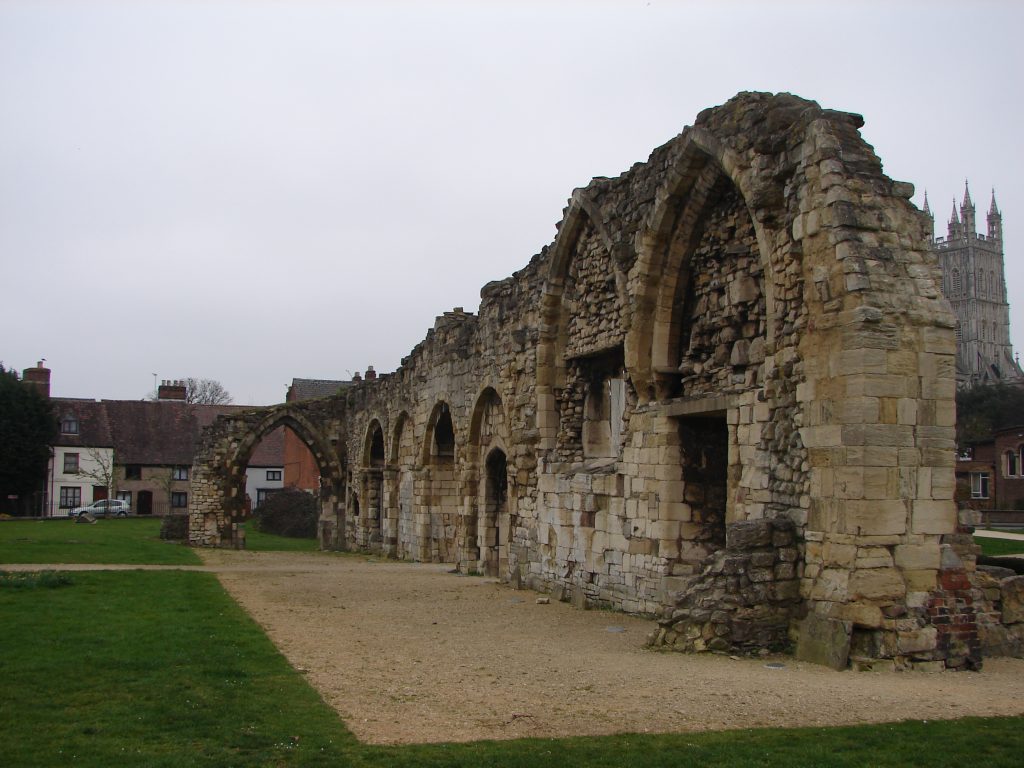In this blog, I am continuing to discuss the importance of the medieval church as found in my West Country medieval mystery series featuring my heroine, the Lady Apollonia of Aust. I have already talked about cathedral churches and important abbeys. Last month I discussed several other abbeys and priories in my second story, Plague of a Green Man.
This month I point out other monasteries referred to in my third book, Memento Mori. Most of the monasteries of England were destroyed during King Henry VIII’ s Dissolution of them in the 16th century. The pictures in this posting give an idea of some buildings and ruins that have survived. Glastonbury Abbey in Somerset plays a role in my story, but it involves a subplot, not the main mystery. The ruins of its Lady Chapel are shown above. Saint Oswald’s Priory in Gloucester, however, does play a major role in the mystery story, and its ruins are shown in the next two pictures. The first shows me with two friends, one from Indiana and the other a prominent local Gloucester historian, the second picture another view of the ruins.
Memento Mori mentions more monasteries than any other book in my series because Laston, the squire to Lady Apollonia’s fourth son, Alban, stays at the following abbeys and priories spread across southern England as he makes his way back from the Continent in search of the Lady. Stops on his route include Boxley Abbey in Kent, Saint Mary’s Abbey at West Melling, Waverly Abbey in Surrey, the Priory of Selbourne in Hampshire, and Glastonbury Abbey in Somerset. They are mentioned in this story, but they play no further role.
Saint Oswald’s Priory, on the other hand, is integral to the plot because of the evil doings of one of its monks. This priory goes back to the late 9th century but diminished in importance after the 11th century. Up until the rebuilding of Saint Peter’s Abbey in 1089, which became Gloucester Cathedral, Saint Oswald was the primary destination for pilgrims coming to Gloucester. After that, it became a minor house of Augustinian canons until the dissolution of the monasteries in 1536.
Finally, the Gilbertine Order appears in Memento Mori when Brother William, Lady Apollonia’s Almoner, reveals the difficulties he experienced as a young man as a member of this order in Lincolnshire. The order was founded by a priest named Gilbert who started it for nuns practicing the Cistercian Order in 1131. Within a few years lay sisters, lay brothers and male canons had been added to the enterprise.
Gilbert sought help from the Cistercians in France to run his new order. When they declined, he founded the Gilbertine Order by combining aspects of the Benedictine and the Cistercian Orders. The Gilbertine Order is the only monastic order founded by Englishmen. Although the two genders in the Gilbertine Order were separated except when attending mass, Brother William’s difficulties arose from the inclusion of both men and women in the order.
I hope to see you again next time.



